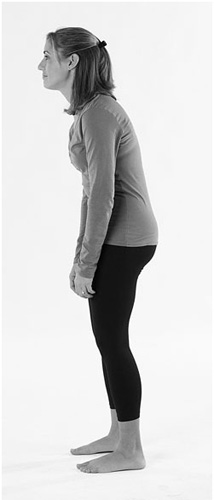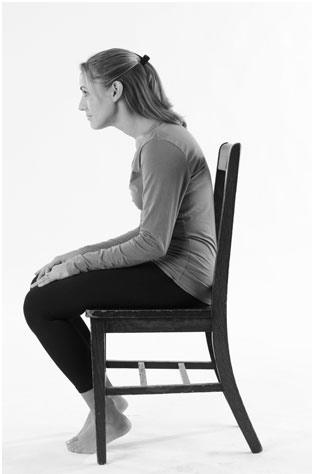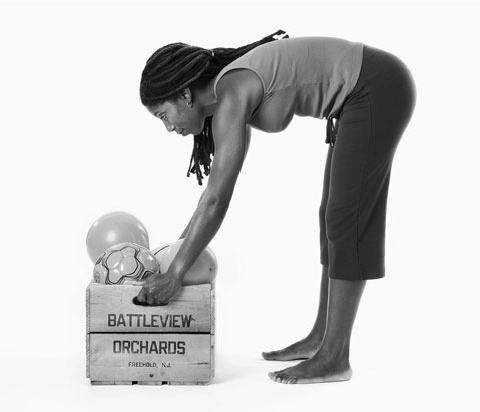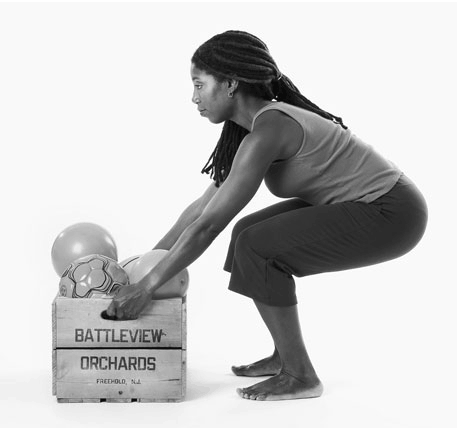
Copyright © 2009 by Amy Stein. Click here for terms of use.
Stress and pelvic floor disorders turn together in a vicious circle. Relaxing and taking care of yourself are therefore a critical part of the natural way to healing.
As we have seen, tension and anxiety, whether from a traumatic event or from the strains and worries that are scattered through every life, tend to "settle" in the core of the body, shortening and tightening the muscles of the pelvic floor, the back, and the abdomen and leading to the cascade of pain and dysfunction we've talked about earlier.
Such stress also sets up a physiological response that can suppress the immune system. When that happens, any area of the body that is already weak or in pain becomes something of a target—that is, it's more susceptible than ever to infection, to further weakening, to more tension, to other problems.
Moreover, stress can keep you from sleeping well, and since sleep is the time when your body repairs itself and renews its tissues, the stress of pelvic floor disorders can work against the healing process. In fact, insomnia contributes significantly to the suppression of the immune system as well.
The bottom line is that stress is particularly bad for you if you have a pelvic floor dysfunction or weak pelvic floor muscles. It usually makes the condition worse, and it contributes to the rotating cascade of pain the dysfunction or weakness gives rise to. So for any diagnosis of pelvic disorder, pain, or weakness, learning how to manage your stress and practicing self-care to stay relaxed are essential prescriptions.
But managing stress can mean all sorts of different things to different people, and it's important to keep in mind not just that everybody is different, but that every body is different. We all have our own DNA signature, as individual to us as our fingerprints, and we all respond in different ways to stress and the processes for reducing stress. I know lots of people who swear by meditation. I know others who need a hot bath and soothing music. Some people chill out by watching a funny movie, while others head to the gym for a sweaty workout. For me, it takes some stretching and deep breathing or some form of cardiovascular exercise like Rollerblading, snowboarding, or skiing to clear my head, reinvigorate my energy level, and get rid of the strains and anxieties that come with running a business, managing a household, caring for patients, and being engaged in personal relationships with family and friends.
The point is that whatever works to relax you and lower your stress will also help heal your pelvic floor disorder—and, most of the time, vice versa. (Of course, all the exercises of the End-the-Pain and Strengthen-the-Muscles routines you learned in Chapters 3 and 4 and the massage therapies of Chapter 5 are key to managing stress and healing pelvic floor disorders.) Still, this chapter will focus on methods that have proven particularly effective in lengthening and relaxing the pelvic floor, surrounding muscles, and the nervous system to send the tension and pain packing. So regard the suggestions in this chapter as just that—suggestions. None of them can do you any harm whatsoever; all have the potential to do you good. The important thing is to see what works for you and then to make those techniques and self-care initiatives a part of your healing program—and a part of your life.
Actually, back in Chapter 3, you already learned what is perhaps the most important—and certainly the most basic—stress management technique there is: deep breathing. Here's a refresher course:
• Inhale. Expand your belly outward and your ribs to the sides and "open" your pelvic floor, without lifting your chest. Feel the air filling the "receiving area" of your lungs, making one big chamber. Inhale for three to five seconds.
• Exhale. Start from the top. Let the air out of your upper lungs, then relax your ribs, your belly, and your pelvic floor so that the air just gradually flows out of you. Exhale for four to six seconds.
I've already recommended that you start every day with deep breathing and that you make it a key part of your exercise program. In addition, do it whenever you feel particularly tense, when you note that your breathing has grown shallow and quick, or when you feel anxious in your mind or body.
Deep breathing requires no special tools. You can do it anywhere and at any time. And it's absolutely free. Yet it's one of the most effective ways I know of to calm your nerves, banish anxiety from your body and mind, and relieve pain and muscle tension. Whenever you feel stressed, your first move should be to take a deep breath.
If you suffer from any of the bladder or bowel problems listed in Chapter 3—urgency, frequency, retention, or pain—here are some tips for relaxing when you are on the toilet.
To begin with, one good way to relax the pelvic floor is to place a stool underneath your feet as you are seated on the toilet. Use a couple of phone books if you don't have a stool the right height.
Then, don't rush it, and don't strain. Breathe, and try to relax.
Instead, if your issue is your bladder, try massaging the area right over the bladder—the lower center of the abdomen just above the pubic bone. Use any of the techniques you learned in Chapter 5 and just stroke the area for a minute or so. If the bowel is your problem, do the ILU massage from Chapter 5—again, for a minute or so.
Relaxing in these ways can facilitate a more efficient emptying of your bladder and bowel.
Deep breathing can even help relieve bladder and bowel urgency and frequency as well as urge incontinence. Use it for what is called the key-in-the-lock syndrome. I'll explain:
If you drink a mug or two of coffee in the morning, the normal tendency is to feel the urge to urinate after about an hour. So if you feel the urge to urinate within 10 minutes of your cup of coffee, and then another 10 minutes after that, and again 10 minutes later, that is not normal.
It's just like what happens when you feel the urge to urinate, arrive home, and just as you are putting the key in the lock, you get an intense urge and you begin to leak—or to feel you are leaking, even if it is not the case.
What's going on—and how can you control these untimely and inconvenient urges?
Although it is called key-in-the-lock, the real name for this is urgency-frequency syndrome or urge incontinence—the feeling that you have to go and that you will not be able to hold it in till you reach a toilet. It is both a cause and a result of stress; in fact, it's one of the most stressful things an individual confronts, with the worry about its future occurrence as bad as the urge itself. What can you do about it?
First, as noted, deep-breathe and drop the pelvic floor muscles five to 10 times. Although it seems counterintuitive to relax the muscles when you feel a strong urge, it works. If your pelvic floor muscles are already shortened, and you are tightening them every time you have the urge, then you are shortening the muscles even more and are fatiguing them as well, which is precisely what can lead to urgency-frequency syndrome and/or urge incontinence.
Second, think thoughts that can relax you. One good bet is to visualize a place where you have felt utterly relaxed and at ease. Maybe it's that tropical beach where you vacationed a couple of years ago. Maybe it's a cabin in the North Woods where you've always hoped to get snowed in. Picture the place—palm trees and white sand, or deep snowdrifts and a warm fire. In your mind, place yourself there. Now relax.
In the beginning, you are only trying to control the urge for a brief time—another 10 minutes perhaps. You are not trying to "hold it in" for the full hour considered "normal" after drinking coffee, or for an exaggerated distance to the nearest bathroom. Ten more minutes this week, maybe another 10 next week as the muscles learn to relax through practice, then another five the week after—and so on. In due course, you will have taught your muscles to relax and lengthen so that the urgency will abate.
As you retrain your pelvic floor muscles, be sure to take care of the rest of your body as well, for doing so enhances the healing of your pelvic floor. The best place to practice total-body stress reduction and self-care is in the privacy and comfort of your own home.
You can pay a fortune to go to an upscale destination resort spa—or you can practice stress reduction for free, in your own neighborhood and right in your own home.
You might start off your relaxing time with a walk in the park—maybe just a languid stroll today, or maybe a brisk constitutional to get your circulation going. Both can reduce stress.
Top it off when you get home with a hot bath. Fill the tub, light the candles, turn on the music, turn off the telephone, and sink down into the water. Let the heat suffuse your body till you can feel yourself relaxing. Empty your mind. Listen only to the music, not to that to-do list in your head. This is your time; take advantage of it. When you're ready to climb out, stretch the warmth with a cup of tea—maybe chamomile or mint, which calm the stomach—to relax you even further. Dress in loose-fitting clothing; tight clothing can increase skin irritations and can decrease blood flow. Sit down in your favorite chair. Special cushions to alleviate pain in your tailbone, sit-bone area, or perineum may help; search on "sitting cushions" on the Internet for sources. Read a book. Write a letter. Watch a movie.
Maybe yoga is your thing: loose clothing, a mat on the floor, quiet time to focus on the postures.
Do you know how to do meditation? It isn't hard to learn, but there is a right way to do it—and many books, tapes, and online courses that teach the right way. Once you learn how, it's a great way to gain a sense of calm and stability that lasts. And, like deep breathing, it's something you can do anywhere, any time for a few minutes to get a quick hit of stress reduction.
Interested in some special techniques for soothing the pelvic area? Try lying down on your back and elevating your pelvis with pillows or a wedge. Especially if you have the kind of job that keeps you on your feet all day, this can help improve your circulation and reverse the blood flow away from your pelvic area where it has probably congested during the day.
While you're lying there, give yourself what's called an effleu-rage massage. Put some oil or lotion on your fingertips or palms and just gently stroke your abdomen and pelvic region. This massage warms and relaxes the muscles and helps to improve blood flow.
For even more relaxing warmth, use a hot water bottle or heating pad. Place the bottle or pad right on the abdomen to help relax your bladder and bowel. Or, lying on your stomach, place the bottle or pad on the tailbone or back right on top of any pelvic pain you may be suffering to loosen muscle tightness, increase blood flow, and relax the muscles. If you suffer from any sort of bladder urgency, frequency, or pain, or if you're experiencing constipation, diarrhea, or irritable bowel, applying heat in this way can calm the gut and relax the muscles as well. You can do this warmth therapy as often as you like and throughout the day, but do not place a heating pad on your belly if you are pregnant or if you have any condition for which the application of heat is contraindicated.
If your skin is irritated anywhere around the anal region, or if you're a woman who has pain at penetration during sex, or if you suffer from tailbone or any pelvic pain, try a contrast bath: stroke the affected area with an ice cube for one minute—be sure to move it around so it doesn't burn your skin, then apply a warm washcloth for one minute. The ice cools and thus decreases the inflammation and calms muscle spasm, while the warmth increases the blood flow and relaxes tight muscles and tissues. So both assist the healing process. That is why you should repeat the procedure anywhere from three to five times, and do it up to three times a day.
Any and all of these methodologies can help heal your pelvic floor disorder because they help relax the mind and banish tension from the body. They cost little or no money; they don't require the involvement of others; they don't call for any special equipment. No doubt there are other things you like to do to relax. Whichever techniques work for you, incorporate them into your life; they're an important part of healing your pelvic floor disorder, and they're important for your overall health as well.
One of the best ways to take care of yourself to ensure a healthy pelvic floor for life is to maintain proper posture and body alignment. The reason is simple: poor posture and muscle imbalance can cause and certainly contribute to pelvic floor dysfunction. Think about it: if your body is not properly aligned, if you slouch or are off balance, your organs are off balance and out of alignment as well. Your muscles are shortened where they should be long and are lengthened where they should be short, and the bottom line is that your body is simply not functioning effectively or efficiently. Here's why:


Our joints contain nerve endings called proprioceptors that tell us where we are in space. If you have spent years slouching, for example, with your head forward and your shoulders rounded, your body's proprioception may now accept the slouching as the norm. In this norm, however, your abdominal muscles have shortened and reduced the space in your abdominal cavity where your pelvic organs reside; the result is there's less mobility in the abdominal cavity. Your slouched norm has also resulted in lengthening your back muscles, which now have a difficult time contracting efficiently. Your posture is forcing your back muscles to work harder, and chances are good you have fairly chronic back pain.
That proprioception is going to be hard to break through after all these years, so you'll need to do posture exercises frequently and on a regular basis till you retrain your nerve endings and reeducate your muscles to good posture and proper alignment. Do the following exercises three times daily at first, then once a day for your lifetime. All you need is a wall.
1. Stand against the wall with your shoulders back so that your shoulder blades, head, buttocks, and heels are all touching the wall. Look straight ahead. Bend your knees slightly, and contract your abdominal muscles very gently; do not suck in your stomach, just bring your belly button toward your spine. This is the easy part of the exercise. Now, hold the posture, and try to memorize what it feels like in your body. (If you have a full-length mirror, it can be helpful to position it so that by turning your head, you can see the side view of yourself holding the posture.) Got it? Okay, now take a couple steps away from the wall. Try to maintain the posture as you do so, and try to maintain it throughout the day, but be careful not to hold yourself too stiff. Maintaining the posture without the help of the wall is the hard part of the exercise. You will probably need to remind yourself of how the posture felt in your body multiple times until it becomes a habit, as it will in time.
2. Do the same thing seated. (If you have any pain, try sitting on a cushion or a pillow.) Sit against a wall with your shoulder blades, head, and buttocks touching the wall. Look straight ahead. Gently contract your abdomen by bringing your belly button toward your spine—do not suck in your stomach. Memorize how the posture feels, and try to maintain it while sitting at your desk or commuting by bus or train or in whatever sitting you do during the day. A lumbar cushion may help, as is shown in the photo.
At first as you do these exercises, you may find that you need to remind yourself of what the posture feels like repeatedly during the course of a day. You may also find that you can only hold the posture, standing or seated, for a few minutes or even a few seconds at a time. But I promise you that as you keep at it, you will improve. Next week, you'll only need to remind yourself of the posture 10 times a day, and you may be able to maintain the posture for 10 minutes at a stretch. Remember: it is a matter of reeducating your muscles out of bad habits and retraining your body's proprioceptors. It takes time—and practice.
In addition to standing properly, it's important to lift properly. The following photo demonstrates poor lifting. Lift from the legs; don't use your back. Stand as close as possible to the item to be lifted. Then perform a squat: keep your back straight, bend at the hip and the knee, take up the item, and use your abdominals to stand up straight. The second photo shows you how.


An important part of the self-care that can keep you healthy at the core is emotional support. As has been noted, the whole topic of pelvic floor disorders has been "hush-hush" for years, and you can't get the support you need if you can't talk about the problem. In fact, one of the reasons I've written this book is in hopes of making pelvic floor pain and disorder an accepted topic of conversation, for only in that way can people who suffer the disorders find the healing they need.
The first place to go for support is to family members or friends. Not only will they be understanding; you are also likely to learn that someone you know is also suffering from some form of pelvic floor dysfunction or has suffered from it in the past. These are your nearest and dearest; they love you and don't want you to be in pain and discomfort, or to feel embarrassed or ashamed. Talk to them.
But family and friends are not your only resource. In fact, while family and friends will offer the support of love and comfort, you may need more direct professional guidance to deal with the impact of your dysfunction on your life. And if you are someone who simply is not comfortable talking to a friend or family member about your condition, a professional should be your first stop. Try to find a psychologist, social worker, psychiatrist, or other therapist who is familiar with pelvic pain and with urinary, bowel, or sexual dysfunction. If that particular expertise is not available where you live, then look for someone with specialized training in chronic pain or, at a minimum, in stress management. In addition, most studies show that cognitive behavioral therapy is an excellent technique for managing the stress and anxiety of pelvic floor disorder, so you might want to narrow your search to experts in that discipline. Many of the associations listed in Appendix B in the back of this book can help you find the right professional resource to meet your needs.